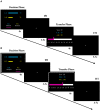Helping or punishing strangers: neural correlates of altruistic decisions as third-party and of its relation to empathic concern
- PMID: 25741254
- PMCID: PMC4332347
- DOI: 10.3389/fnbeh.2015.00024
Helping or punishing strangers: neural correlates of altruistic decisions as third-party and of its relation to empathic concern
Abstract
Social norms are a cornerstone of human society. When social norms are violated (e.g., fairness) people can either help the victim or punish the violator in order to restore justice. Recent research has shown that empathic concern influences this decision to help or punish. Using functional magnetic resonance imaging (fMRI) we investigated the neural underpinnings of third-party help and punishment and the involvement of empathic concern. Participants saw a person violating a social norm, i.e., proposing unfair offers in a dictator game, at the expense of another person. The participants could then decide to either punish the violator or help the victim. Our results revealed that both third-party helping as well as third-party punishing activated the bilateral striatum, a region strongly related with reward processing, indicating that both altruistic decisions share a common neuronal basis. In addition, also different networks were involved in the two processes compared with control conditions; bilateral striatum and the right lateral prefrontal cortex (lPFC) during helping and bilateral striatum as well as left lPFC and ventral medial prefrontal cortex (vmPFC) during punishment. Further we found that individual differences in empathic concern influenced whether people prefer to help or to punish. People with high empathic concern helped more frequently, were faster in their decision and showed higher activation in frontoparietal regions during helping compared with punishing. Our findings provide insights into the neuronal basis of human altruistic behavior and social norm enforcement mechanism.
Keywords: empathic concern; reward; striatum; third-party help; third-party punishment.
Figures






Similar articles
-
Punish the Perpetrator or Compensate the Victim? Gain vs. Loss Context Modulate Third-Party Altruistic Behaviors.Front Psychol. 2017 Nov 28;8:2066. doi: 10.3389/fpsyg.2017.02066. eCollection 2017. Front Psychol. 2017. PMID: 29234295 Free PMC article.
-
The Role of Compassion in Altruistic Helping and Punishment Behavior.PLoS One. 2015 Dec 10;10(12):e0143794. doi: 10.1371/journal.pone.0143794. eCollection 2015. PLoS One. 2015. PMID: 26655837 Free PMC article.
-
What drives the (un)empathic bystander to intervene? Insights from eye tracking.Br J Soc Psychol. 2020 Jul;59(3):733-751. doi: 10.1111/bjso.12354. Epub 2019 Dec 2. Br J Soc Psychol. 2020. PMID: 31792985
-
Neural components of altruistic punishment.Front Neurosci. 2015 Feb 9;9:26. doi: 10.3389/fnins.2015.00026. eCollection 2015. Front Neurosci. 2015. PMID: 25709565 Free PMC article. Review.
-
The neuronal basis of empathy and fairness.Novartis Found Symp. 2007;278:20-30; discussion 30-40, 89-96, 216-21. Novartis Found Symp. 2007. PMID: 17214308 Review.
Cited by
-
Norms and the Flexibility of Moral Action.Personal Neurosci. 2018 Sep 7;1:e15. doi: 10.1017/pen.2018.13. eCollection 2018. Personal Neurosci. 2018. PMID: 32435734 Free PMC article. Review.
-
Optimizing the social utility of judicial punishment: An evolutionary biology and neuroscience perspective.Front Hum Neurosci. 2022 Sep 12;16:967090. doi: 10.3389/fnhum.2022.967090. eCollection 2022. Front Hum Neurosci. 2022. PMID: 36171873 Free PMC article.
-
The neurostructural bases of empathy: morphometric evidence for a multicomponential approach.Front Psychiatry. 2025 Apr 10;16:1544632. doi: 10.3389/fpsyt.2025.1544632. eCollection 2025. Front Psychiatry. 2025. PMID: 40276066 Free PMC article.
-
The Effect of Oxytocin on Third-Party Altruistic Decisions in Unfair Situations: An fMRI Study.Sci Rep. 2016 Feb 2;6:20236. doi: 10.1038/srep20236. Sci Rep. 2016. PMID: 26832991 Free PMC article.
-
Self-interest overrides rank-reversal aversion in resource distribution.Sci Rep. 2024 Aug 24;14(1):19704. doi: 10.1038/s41598-024-70225-9. Sci Rep. 2024. PMID: 39181915 Free PMC article.
References
-
- Batson C. D., Quin K. O., Fultz J., Vanderplas M. (1983). Influence of self-reported distress and empathy on egoistic versus altruistic motivation to help. J. Pers. Soc. Psycho. 45, 706–718 10.1037/0022-3514.45.3.706 - DOI
LinkOut - more resources
Full Text Sources
Other Literature Sources

